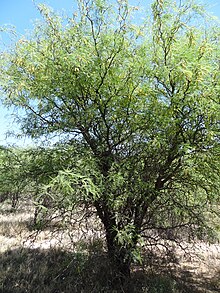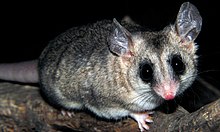Sallow fat-tailed pouch rat
| Sallow fat-tailed pouch rat | ||||||||||||
|---|---|---|---|---|---|---|---|---|---|---|---|---|
| Systematics | ||||||||||||
|
||||||||||||
| Scientific name | ||||||||||||
| Thylamys pallidior | ||||||||||||
| ( Thomas , 1902) |
The pale fat- tailed pouch rat ( Thylamys pallidior ) occurs in the coastal south of Peru, in the southwest of Bolivia, in the north of Chile and in large parts of western and central Argentina. This means that it has the largest distribution area of all fat-tailed rats.
description
The animals reach a head trunk length of 7.3 to 10.5 cm, have a 9 to 11.8 cm long tail and reach a weight of 13 to 38.5 g. The tail, which is used to store fat, is usually 115% of the length of the head. As usual with fat-tailed rats, the hair is banded with three different color zones. The animals are brown-gray in color and are significantly lighter on the sides of the body, face, around the eyes and on the cheeks than on the back and the top of the head. The eyes are surrounded by narrow dark rings that extend far forward towards the nose. The peritoneum is white. The ears are gray and light gray at the base. Front and rear paws are small and whitish. The tail is gray on top and yellowish-white on the underside with a light tip. The females do not have a pouch. The number of teats is usually nine, four on the sides and one in the middle; however, there are also females with 15 teats, one in the middle and seven pairs on the sides. The karyotype of the pale fat-tailed rat consists of a chromosome set of 2n = 14 chromosomes (FN = 20).
The tooth formula is:
Habitat and way of life
The pale fat-tailed rat lives in deserts, semi-deserts and steppes, in the Puna , the Monte and in the Patagonian steppe from sea level to altitudes of around 4500 meters. Large parts of their habitat are rocky and poor in vegetation, others are covered with trees from the genus Polylepis and Prosopis or shrubs from the genus Larrea or various thorn bushes. The animals seem to prefer areas with sufficient vegetation to protect them from predators . Some specimens have also been caught indoors. The pale fat-tailed pouch rat is nocturnal and terrestrial (living on the ground). However, it also climbs on low shrubs. During the day when she sleeps, her body temperature can drop below 15 ° C. The animals then fall into a torpor .
The pale fat-tailed-pouch rat has the most southern range of all fat-tailed-pouch rats. Other small mammals, in Patagonien are occurring fat-tailed opossum in habitat of Pale Akodon iniscatus and Akodon molinae from the genus of South American field mice , Calomys musculinus from the kind of Vesper mice , Eligmodontia typus of the genus eligmodontia , graomys griseoflavus , the long-tailed dwarf oryzomys ( Oligoryzomys longicaudatus ) and Phyllotis xanthopygus from the genus of leaf ear mice . In the northern Argentina these are the operand field mouse ( Abrothrix andinus ) Akodon albiventer , Akodon Dolores and another undetermined species of the South American field mice, Andalgalomys olrogi and Andalgalomys roigi from the kind of Chaco mice , the Andes mouse ( Andinomys edax ) C. musculinus , the highland gerbils Eligmodontia bolsonensis , Eligmodontia moreni and E. typus , G. griseoflavus , P. xanthopygus and Reithrodon auritus from the genus of rabbit rats .
nutrition
The pale fat-tailed pouch rat feeds primarily on small arthropods , including beetles, arachnids , centipedes , butterflies and two-winged birds , as well as leaves, seeds and fruits. During investigations during the rainy season in the Monte, a dry, steppe-like bushland in Argentina, it was found that the animals then only feed on leaves, especially Prosopis flexuosa , and did not eat any animal food. Small rodents, small lizards, birds or bird eggs are rarely eaten. A specimen kept in human care ate up to 20 beetles during the night, cutting off wings and parts of the exoskeleton beforehand . When water is scarce, the pale fat-tailed rat can reduce its urine volume. Like all fat-tailed rats, if there is a good supply of food, it stores fat in its tail, which then becomes four to five times thicker than normal (ø 10 mm and more). The fat is broken down again in times of scarce food or during a torpor.
Reproduction
To reproduce, the pale fat-tailed rat builds nests of grass, leaves, feathers and other material in tree hollows, or under bushes or rocks. It reproduces twice a year. In Argentina, females with large milk-secreting teats were found in December and February, and young from February to June. Often the females only have 3 to 4 young animals, fewer than teats are available.
Predators and parasites
Well-known predators of the pale fat - tailed rat are the Magellan owl ( Bubo magellanicus ) and the Brazilian barn owl ( Tyto furcata tuidara ). At one in the Atacama Desert conducted in northern Chile in September examination 25.9% contained the Gewölle the barn owl remains of Pale fat-tailed possum. At that time it was the second most important prey of the bird. Ectoparasites that attack the pale fat- tailed rat are the flea Craneopsylla minervawolffhuegeli and the mite Acanthochela chilensis . In addition, following internal parasites are known: the nematode Pterygodermatitesi kozeki , the tapeworm Mathevotaenia sanmartini and the protozoan parasite Eimeria .
Systematics
The pale fat-tailed rat was first described in 1902 by the British zoologist Oldfield Thomas and assigned to the elegant fat-tailed rat (then Marmosa elegans ) as a subspecies. Today it is considered an independent species and belongs to the genus of the fat- tailed rat ( Thylamys ). Terra typica is Challapata Belén in western Bolivia. The species epithet , derived from the Latin “pallidus”, means “pale”. Thylamys fenestrae is an independent species at the IUCN , but is treated as a synonym for Thylamys pallidior in the marsupial volume of the Handbook of the Mammals of the World . A phylogenetic analysis, in which the mitochondrial DNA encoding cytochrome b was compared , showed that Thylamys pallidior consists of a northern and a southern clade that separated from one another one to two million years ago. The two clades may need to be viewed as different subspecies or species. In addition, a population from the Huancavelica region and the Lima province in Peru , which has so far been included in Thylamys pallidior, is more closely related to Tate's fat- tailed rat ( Thylamys tatei ) and forms a previously unnamed taxon . The sister species of Thylamys pallidior is the elegant fat- tailed pouch rat ( Thylamys elegans ) from central Chile.
The following cladogram shows the relationship between the different species within the Andean clade of Thylamys :
| Thylamys (Andean clade) |
|
||||||||||||||||||||||||||||||
|
|
status
The IUCN lists the pale fat-tailed rat as safe. It has a very large range, is likely to be numerous, and is also found in some protected areas.
literature
- Janet K. Braun, Nathan L. Pratt, Michael A. Mares: Thylamys pallidior (Didelphimorphia: Didelphidae), in Mammalian Species 42 (856): 90-98 January 2010, DOI: 10.1644 / 856.1
supporting documents
- ↑ a b c d e f g h Diego Astúa: Family Didelphidae (Opossums). in Don E. Wilson , Russell A. Mittermeier : Handbook of the Mammals of the World - Volume 5. Monotremes and Marsupials. Lynx Editions, 2015, ISBN 978-84-96553-99-6 . Page 176 a. 177.
- ↑ a b Janet K. Braun, Ronald A. Van Den Bussche, Philip K. Morton, Michael A. Mares: Phylogenetic and Biogeographic Relationships of Mouse Opossums Thylamys (Didelphimorphia, Didelphidae) in Southern South America. Journal of Mammalogy, Volume 86, Issue 1, February 15, 2005, pages 147–159, doi : 10.1644 / 1545-1542 (2005) 086 <0147: PABROM> 2.0.CO; 2
- ↑ Braun, Pratt et al. Mares (2010), 93.
- ↑ a b c Braun, Pratt u. Mares (2010), page 95.
- ↑ Thylamys fenestrae in the Red List of Threatened Species of IUCN 2016 Posted by: Martin, GM & Flores, D., 2016. Accessed on 22/03/2020.
- ↑ a b R. Eduardo Palma, Dusan Boric Bargetto, Pablo Jayat, David A. Flores et a .: Molecular phylogenetics of mouse opossums: new findings on the phylogeny of Thylamys (Didelphimorphia, Didelphidae). Zoologica Scripta 43 (3): 217-234 January 2014, PDF
- ↑ Thylamys pallidior in the Red List of Endangered Species of the IUCN 2015. Posted by: Albanese, MS, Martin, GM, Teta, P. & Flores, D., 2015. Retrieved on March 22, 2020.




